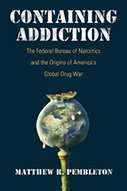Containing Addiction: The Federal Bureau Of Narcotics And The Origins Of America’s Global Drug War

Author: Matthew R. Pembleton
Publisher: Amherst: University of Massachusetts Press, 2017. 336p.
Reviewer: Aileen Teague | October 2018
Pembleton’s ambitious study explores the origins of domestic and overseas U.S. federal drug enforcement efforts carried out by the Federal Bureau of Narcotics (FBN), grandfather organization to the Drug Enforcement Administration (DEA). Focusing on the period between 1930, when the agency was born, until 1968, when it was reorganized and transferred from the Treasury to the Justice department, the study examines how the FBN developed more aggressive, interventionist drug enforcement tactics, some of which are still in use today. The more enduring legacy of the FBN’s efforts, however, was in how it tied issues of U.S. drug addiction to those of national security. Pembleton’s interpretation highlights how FBN actors used the domestic drug problem in ways that expanded the agency’s overseas footprint.
Containing Addiction chronicles how the national consensus over drug control was created and negotiated over time. The first chapter explores the dope menace from the turn of the century to the 1960s. Pembleton pays substantial attention to FBN actors who championed the idea of what he calls the “drug war,” the more criminalized, interventionist domestic and foreign U.S. antidrug strategy emerging with the expansion of the FBN (8). Each of the next seven chapters is organized around significant personalities that helped shape a particular aspect of U.S. drug enforcement. The most influential of these figures was Harry Anslinger, the FBN’s first commissioner who, according to Pembleton, did more to spread the idea of the addict as a threat to society than anyone else. The study concludes with an examination of the FBN’s legacies.
Pembleton deftly sketches the gray areas of developing U.S. drug enforcement practices and ideas, highlighting the tension between the agency and the historical forces of the time, to include the Cold War, the drug war’s “brother from another mother” (41).
Anslinger capitalized on “the rotten apple” analogy to describe how crime and addiction, like communism, spread across borders (53). While Pembleton’s analysis bring to light the largely unexplored narrative of the FBN, a more careful historicization of the language of drug control would have enabled him to offer more compelling answers to the important questions of the development and construction of U.S. drug control he raises throughout the text. The frequently used term, “drug war,” for example, implies a more recent, militarized, and violent execution of drug enforcement not necessarily present in Pembleton’s analysis of the FBN’s earliest assignments, especially as contrasted with the so-called global “war on drugs” of today. That the FBN developed more intensive, policing tactics is evident, but its actions did not amount to war. Similarly, in Chapter 5, Pembleton uses the word “kingpin,” a more recent term of the drug trade, to describe how FBN actors saw major crime bosses and drug traffickers such as the Italian boss, “Lucky” Luciano during the 1940s and 1950s. He is not wrong to emphasize that the FBN created such enemies, which served to reinforce the agency’s power, but to refer to Luciano as a kingpin unfairly places the mobster into a modern-day box that leaves no room to understand how Luciano and other such actors operated as distinct, historical actors of their time.
Aileen Teague, Ph.D., Postdoctoral Fellow, Brown University, The Watson Institute for International & Public Affairs


